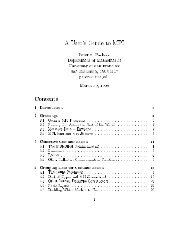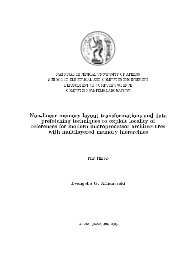Fast and Cost-Effective Online Load-Balancing in - Computing ...
Fast and Cost-Effective Online Load-Balancing in - Computing ...
Fast and Cost-Effective Online Load-Balancing in - Computing ...
Create successful ePaper yourself
Turn your PDF publications into a flip-book with our unique Google optimized e-Paper software.
KONSTANTINOU ET AL.: FAST AND COST-EFFECTIVE ONLINE LOAD-BALANCING IN DISTRIBUTED RANGE-QUERIABLE SYSTEMS 1357<br />
Proof. In an atomic item exchange between two neighbor<strong>in</strong>g<br />
nodes, the load that will be moved from the splitter<br />
to the helper is l ¼ aðL i thres i Þ; 0 L j thres j . tu<br />
Corollary 1. Any load-balanc<strong>in</strong>g action us<strong>in</strong>g NIXMIG between<br />
a splitter node N i <strong>and</strong> a helper node N j leads the system faster<br />
to an equilibrium as long as the helper is underloaded, that is,<br />
L j < thres j .<br />
Proof. The algorithm’s convergence rate is faster as long as<br />
the selection of balanc<strong>in</strong>g partners ensures a larger drop<br />
<strong>in</strong> the value. If L j is underloaded, then the third term<br />
of is larger (as a sum of two positive terms) compared<br />
to the case when L j is overloaded.<br />
tu<br />
Corollary 1 is a special case of Theorem 3 that shows the<br />
importance for the algorithm’s convergence of easily<br />
locat<strong>in</strong>g underloaded peers. In Corollary 2, we identify<br />
the moved load value l opt that maximizes the algorithm’s<br />
convergence rate lead<strong>in</strong>g the system quicker to an equilibrium.<br />
We def<strong>in</strong>e as thdif i ¼ L i thres i the difference of<br />
N i ’s load from its thres i value.<br />
Corollary 2. NIXMIG’s optimum convergence rate is obta<strong>in</strong>ed<br />
when half of the difference of thdif i from thdif j is transferred<br />
from splitter Node N i to helper Node N j , that is,<br />
l opt ¼ 1 2 ðthdif i thdif j Þ.<br />
Proof. as a function of the moved load l is<br />
ðlÞ ¼ðL i thres i Þ 2 þðL j thres j Þ 2<br />
½ðL i lÞ thres i Š 2 ½ðL j þ lÞ thres j Š 2<br />
¼ 2l 2 þ 2ðL i L j þ thres j thres i Þl:<br />
We notice that ðlÞ is a quadratic function of l with<br />
coefficients a ¼ 2, b ¼ 2ðL i L j þ thres j thres i Þ, <strong>and</strong><br />
c ¼ 0. Because a ¼ 2 < 0, ðlÞ has a maximum po<strong>in</strong>t for<br />
l opt ¼<br />
b<br />
2a ¼ 2ðL i thres i þ thres j L j Þ<br />
4<br />
¼ 1 2 ½ðL i thres i Þ ðL j thres j ÞŠ<br />
¼ 1 2 ðthdif i thdif j Þ:<br />
tu<br />
In the case of a homogeneous splitter-helper pair<br />
(thres i ¼ thres j ) from Corollary 2, we notice that<br />
l opt ¼ 1 2 ðL i L j Þ, <strong>and</strong> thus a opt ¼ 1 2 .<br />
5 EXPERIMENTAL RESULTS<br />
We now present a comprehensive simulation-based evaluation<br />
of our method on our own discrete event simulator<br />
written <strong>in</strong> Java. The time unit <strong>in</strong> our simulation is assumed<br />
to be equal to the time needed by a node to perform an<br />
operation with another node. Such operations <strong>in</strong>clude<br />
atomic item exchanges, lock requests, one-hop query<br />
rout<strong>in</strong>g messages, etc. For <strong>in</strong>stance, a LOCALWAVE<br />
wave of ttl ¼ 5 takes five time units to complete. For the<br />
rema<strong>in</strong><strong>in</strong>g of the experimental section, we consider the time<br />
unit to be equal to one second. Start<strong>in</strong>g off from a pure Skip<br />
Graph implementation, we <strong>in</strong>corporate our onl<strong>in</strong>e balanc<strong>in</strong>g<br />
algorithms on top. By default, we assume a network<br />
size of 500 nodes, all of which are r<strong>and</strong>omly chosen to<br />
<strong>in</strong>itiate queries at any given time.<br />
Dur<strong>in</strong>g the start-up phase, each node stores <strong>and</strong> <strong>in</strong>dexes<br />
an equal portion of the data, M N<br />
keys. By default, we assume<br />
50K keys exist <strong>in</strong> the system, thus each node is <strong>in</strong>itially<br />
responsible for 100 keys.<br />
Queries occur at rate r ¼ 250 queries=sec with exponentially<br />
distributed <strong>in</strong>terarrival times <strong>in</strong> a 4,000 sec total<br />
simulation time. Each requester creates a range by choos<strong>in</strong>g<br />
a start<strong>in</strong>g value accord<strong>in</strong>g to some distribution. The range<br />
of each created query is constant, <strong>and</strong> for the 50K sett<strong>in</strong>g it<br />
is equal to 100 keys (i.e., every range query requests 100<br />
consecutive keys). The total network workload is a product<br />
of the query range with the query arrival rate, i.e., w tot ¼<br />
250 queries=sec 100 keys=query ¼ 25:000 keys=sec (<strong>in</strong> every<br />
second, around 25K keys are requested <strong>in</strong> total). Recall from<br />
Section 4.3 that <strong>in</strong> the ideal balanced state of an homogeneous<br />
network, each node should get an equal load<br />
portion of w ¼ wtot<br />
N ¼ 25:000<br />
500<br />
¼ 50 keys=sec.<br />
In our experiments, we utilize several different distributions<br />
to simulate skew: A zipfian distribution, where the<br />
probability of a key i be<strong>in</strong>g asked is analogous to i <strong>and</strong> a<br />
pulse distribution, where a range of keys has a constant load<br />
<strong>and</strong> the rest of the keys are not requested. By alter<strong>in</strong>g the<br />
parameters of each distribution (e.g., the parameter, the<br />
width of the pulse, etc), we manage to create more or less<br />
skewed workloads to test our algorithms.<br />
A node calculates its load us<strong>in</strong>g a simple mov<strong>in</strong>g average<br />
variable that stores the number of the keys it has served<br />
over a predef<strong>in</strong>ed time w<strong>in</strong>dow. To m<strong>in</strong>imize fluctuation<br />
caused by <strong>in</strong>adequate sampl<strong>in</strong>g, this time w<strong>in</strong>dow is set to<br />
around 700 seconds. S<strong>in</strong>ce nodes <strong>in</strong> the beg<strong>in</strong>n<strong>in</strong>g of the<br />
simulation do not have enough samples to estimate their<br />
load, we let the system stabilize on the <strong>in</strong>put workload for<br />
700 seconds without perform<strong>in</strong>g any balanc<strong>in</strong>g operation.<br />
In the follow<strong>in</strong>g, we plan to demonstrate the effectiveness<br />
of our protocol to m<strong>in</strong>imize overloaded peers <strong>and</strong><br />
create a load-balanced image of the system. As we<br />
mentioned before, we are <strong>in</strong>terested <strong>in</strong> the result<strong>in</strong>g load<br />
distribution (<strong>in</strong> terms of overloaded servers <strong>and</strong> ), the rate<br />
at which this is achieved (measured <strong>in</strong> seconds), as well as<br />
the cost measured <strong>in</strong> the number of exchanged messages<br />
<strong>and</strong> items.











